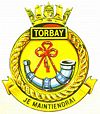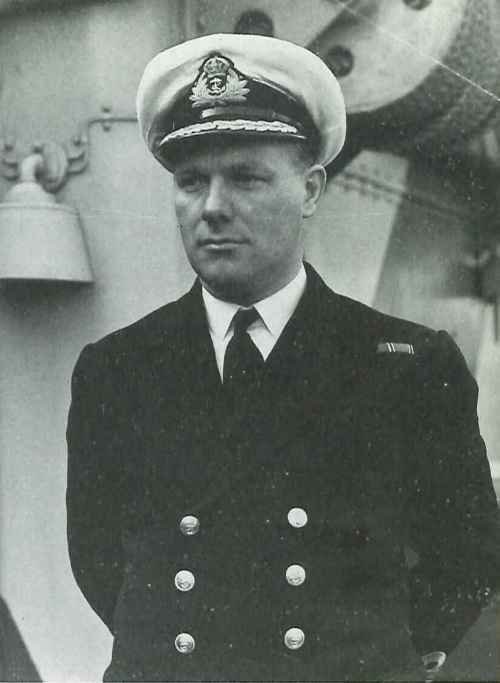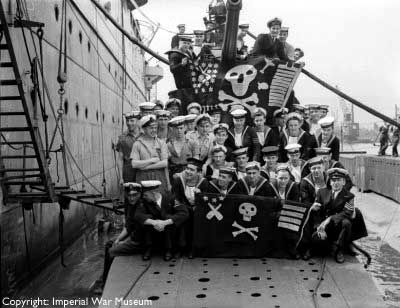 1941 – 1942 / 1st Submarine Flotilla – Alexandria – Egypt
1941 – 1942 / 1st Submarine Flotilla – Alexandria – Egypt
Το βρετανικό υποβρύχιο HMS Torbay κατασκευάστηκε στα ναυπηγεία Chatam Dockyard της Αγγλίας και καθελκύσθηκε στις 9 Απριλίου του 1940. Ήταν το τελευταίο από τα 15 υποβρύχια τύπου Triton Class, που κατασκευάστηκαν ανάμεσα στο 1936 και 1940 για το Βρετανικό Βασιλικό Ναυτικό. Το HMS Torbay είχε μια καριέρα γεμάτη επιτυχίες, καθώς κατάφερε να βυθίσει 17 εμπορικά πλοία συνολικού τονάζ 38.000 κόρων, 5 πολεμικά πλοία και 24 πετρελαιοκίνητα.
 Τέθηκε σε υπηρεσία στις 15 Ιανουαρίου του 1941, κάτω από τις διαταγές του κυβερνήτη Lieutenant Commander Anthony Miers, με το ψευδώνυμο “Crap“, ο οποίος αργότερα ως Ναύαρχος στέφθηκε ιππότης της κατηγορίας KBE (Knights Commander of the Order of the British Empire), αποκτώντας τον τίτλο του Sir. Μετά από σύντομες αποστολές στον Βισκαϊκό Κόλπο και τον Ατλαντικό (22 Μαρτίου – 13 Απριλίου 1941), κατευθύνθηκε -κατόπιν εντολής του Βρετανικού Ναυαρχείου-, προς την Μεσόγειο με τελικό προορισμό την Αλεξάνδρεια, όπου εντάχθηκε στον εκεί εδρεύοντα πρώτο στολίσκο υποβρυχίων (1st Submarine Flotilla – Alexandria –Egypt). Στον στολίσκο αυτόν ανήκε επίσης το υποβρύχιο HMS Talisman, καθώς και το γνωστό HMS Perseus (κλάσης Parthian), το οποίο βυθίστηκε από νάρκη στα νοτιοανατολικά της Κεφαλονιάς στις 6 Δεκεμβρίου του 1941 και εντοπίσθηκε, από τον πρωτοπόρο δύτη Κώστα Θωκταρίδη, στις 25 Δεκεμβρίου του 1997.
Τέθηκε σε υπηρεσία στις 15 Ιανουαρίου του 1941, κάτω από τις διαταγές του κυβερνήτη Lieutenant Commander Anthony Miers, με το ψευδώνυμο “Crap“, ο οποίος αργότερα ως Ναύαρχος στέφθηκε ιππότης της κατηγορίας KBE (Knights Commander of the Order of the British Empire), αποκτώντας τον τίτλο του Sir. Μετά από σύντομες αποστολές στον Βισκαϊκό Κόλπο και τον Ατλαντικό (22 Μαρτίου – 13 Απριλίου 1941), κατευθύνθηκε -κατόπιν εντολής του Βρετανικού Ναυαρχείου-, προς την Μεσόγειο με τελικό προορισμό την Αλεξάνδρεια, όπου εντάχθηκε στον εκεί εδρεύοντα πρώτο στολίσκο υποβρυχίων (1st Submarine Flotilla – Alexandria –Egypt). Στον στολίσκο αυτόν ανήκε επίσης το υποβρύχιο HMS Talisman, καθώς και το γνωστό HMS Perseus (κλάσης Parthian), το οποίο βυθίστηκε από νάρκη στα νοτιοανατολικά της Κεφαλονιάς στις 6 Δεκεμβρίου του 1941 και εντοπίσθηκε, από τον πρωτοπόρο δύτη Κώστα Θωκταρίδη, στις 25 Δεκεμβρίου του 1997.
 To HMS Torbay παρέμεινε στην ανατολική και κεντρική Μεσόγειο εκτελώντας πολλές αποστολές και περιπολίες, με κορυφαίες ανάμεσα τους την επιχείρηση Flipper (Operation Flipper, Νοέμβριος 1941) -την οποία πραγματοποίησε σε συνεργασία με το υποβρύχιο HMS Talisman-, και την επίθεση εναντίον μιας νηοπομπής του Άξονα στο κανάλι της Κέρκυρας τον Μάρτιο του 1942, κατά την διάρκεια της οποίας το υποβρύχιο παρέμεινε επί 17 συνεχείς ώρες σε εχθρικά νερά. Για την επιχείρηση αυτή απονεμήθηκε στον κυβερνήτη του, Anthony Miers, ο σταυρός της Βικτόριας (Victoria Cross).
To HMS Torbay παρέμεινε στην ανατολική και κεντρική Μεσόγειο εκτελώντας πολλές αποστολές και περιπολίες, με κορυφαίες ανάμεσα τους την επιχείρηση Flipper (Operation Flipper, Νοέμβριος 1941) -την οποία πραγματοποίησε σε συνεργασία με το υποβρύχιο HMS Talisman-, και την επίθεση εναντίον μιας νηοπομπής του Άξονα στο κανάλι της Κέρκυρας τον Μάρτιο του 1942, κατά την διάρκεια της οποίας το υποβρύχιο παρέμεινε επί 17 συνεχείς ώρες σε εχθρικά νερά. Για την επιχείρηση αυτή απονεμήθηκε στον κυβερνήτη του, Anthony Miers, ο σταυρός της Βικτόριας (Victoria Cross).
Κατά την διάρκεια της τρίτης περιπολίας του στο Αιγαίο (28 Ιουνίου – 15 Ιουλίου 1941), το HMS Torbay βύθισε τις πρωινές ώρες της 2ας Ιουλίου το ιταλικό επιβατηγό πλοίο Città di Tripoli, στο κανάλι της Κέας. Το Città di Tripoli, το οποίο ήταν επιταγμένο σαν βοηθητικό καταδρομικό, αποτελούσε μέλος μιας νηοπομπής συνοδευόμενης από δυο αντιτορπιλικά τα οποία αντεπιτέθηκαν στο HMS Torbay ρίχνοντας 18 βόμβες βυθού, χωρίς να καταφέρουν να το πλήξουν.

Το καλοκαίρι του 1942 το HMS Torbay ταξίδεψε στην Αγγλία, όπου πραγματοποιήθηκαν κάποιες αλλαγές στον εξοπλισμό του. Τον Φεβρουάριο του 1943 επέστρεψε και πάλι στην Μεσόγειο, κάτω από τις διαταγές του νέου του κυβερνήτη Lieutenant Commander Robert Clutterbuck (8th Flotilla – Algeria). Μετά την αποπεράτωση των πολεμικών ενεργειών στην Μεσόγειο, το HMS Torbay αποσπάσθηκε στην Άπω Ανατολή όπου και συμμετείχε στις επιχειρήσεις του 2ου στολίσκου του Βρετανικού Βασιλικού Ναυτικού (2nd Flotilla – East India Fleet) στην Σουμάτρα και την Ταϊλάνδη, κάτω από τις διαταγές του Lieutenant Compton Patrick Norman. Μετά το τέλος του πολέμου πουλήθηκε για διάλυση, η οποία πραγματοποιήθηκε στο Briton Ferry της Ουαλίας τον Μάρτιο του 1947. Ιδιαίτερη μνεία πρέπει να γίνει στο γεγονός ότι τo HMS Torbay και το HMS Trident, ήταν τα μόνα από τα 15 υποβρύχια της κλάσης Triton που βγήκαν αλώβητα από τον πόλεμο.
 Η ιστορία και οι επιτυχίες του HMS Torbay, είναι άμεσα συνδεδεμένες με τον πρώτο του αμφιλεγόμενο κυβερνήτη Anthony “Crap” Miers. Στις επιτυχίες αυτές συγκαταλέγονται και δυο γεγονότα, για τα οποία ο Anthony “Crap” Miers επιπλήχθηκε από το Βρετανικό Ναυαρχείο, και κατηγορήθηκε από την Γερμανική πλευρά σαν εγκληματίας πολέμου. Πρόκειται για τις επιθέσεις που πραγματοποίησε το HMS Torbay, στις 4 και στις 9 Ιουλίου του 1941. Η πρώτη επίθεση πραγματοποιήθηκε ενάντια σε δυο, από τον Γερμανικό στρατό επιταγμένα, ελληνόκτητα πετρελαιοκίνητα στα νοτιοανατολικά του Κάβο Ντόρο, και η δεύτερη ενάντια σε ένα στολίσκο τεσσάρων επιταγμένων ελληνόκτητων πετρελαιοκίνητων βόρεια των Αντικυθήρων. Και στις δυο περιπτώσεις ο Anthony “Crap” Miers κατηγορήθηκε ότι εκτέλεσε εν ψυχρώ τους διασωθέντες ναυαγούς, αρνούμενος να συλλάβει αιχμαλώτους.
Η ιστορία και οι επιτυχίες του HMS Torbay, είναι άμεσα συνδεδεμένες με τον πρώτο του αμφιλεγόμενο κυβερνήτη Anthony “Crap” Miers. Στις επιτυχίες αυτές συγκαταλέγονται και δυο γεγονότα, για τα οποία ο Anthony “Crap” Miers επιπλήχθηκε από το Βρετανικό Ναυαρχείο, και κατηγορήθηκε από την Γερμανική πλευρά σαν εγκληματίας πολέμου. Πρόκειται για τις επιθέσεις που πραγματοποίησε το HMS Torbay, στις 4 και στις 9 Ιουλίου του 1941. Η πρώτη επίθεση πραγματοποιήθηκε ενάντια σε δυο, από τον Γερμανικό στρατό επιταγμένα, ελληνόκτητα πετρελαιοκίνητα στα νοτιοανατολικά του Κάβο Ντόρο, και η δεύτερη ενάντια σε ένα στολίσκο τεσσάρων επιταγμένων ελληνόκτητων πετρελαιοκίνητων βόρεια των Αντικυθήρων. Και στις δυο περιπτώσεις ο Anthony “Crap” Miers κατηγορήθηκε ότι εκτέλεσε εν ψυχρώ τους διασωθέντες ναυαγούς, αρνούμενος να συλλάβει αιχμαλώτους.
___________________________
The British submarine HMS Torbay, built in the Chatam Dockyard shipyards in England, was launched on 9th April 1940. She was the last of the 15 Triton Class submarines, built between 1936 and 1940 for the British Royal Navy. The HMS Torbay had a career full of successes and managed to sink 17 merchant vessels totaling 38,000 tons, 5 warships and 24 diesel powered caiques.
Entered into service on 15th January 1941 under the command of Lieutenant Commander Anthony Miers (nicknamed “Crap”) who later as a Vice Admiral was crowned as a knight of the KBE category (Knights Commander of the Order of the British Empire), acquiring the title of Sir. After short-term missions in the Bay of Biscay and the Atlantic (22nd March – 13th April 1941), was ordered by the British Admiralty to the Mediterranean Sea with the ultimate destination of Alexandria joining the 1st Submarine Flotilla – Alexandria, Egypt. To this flotilla also belonged HMS Talisman and the more famous HMS Perseus (Parthian Class), which was sank by a mine south-east of Cephalonia on 6th December 1941 and was identified by the pioneering diver Kostas Thoctarides on 25th December 1997.
 HMS Torbay remained in the eastern and central Mediterranean performing many missions and patrols, highlighted by the Operation Flipper in November 1941, carried out in cooperation with HMS Talisman, and later by the attack of an Axis convoy in the channel of Corfu in March 1942, during which the submarine remained for 17 consecutive hours in hostile waters. For this brave undertaking the captain Anthony ‘Crap’ Miers was awarded the Victoria Cross.
HMS Torbay remained in the eastern and central Mediterranean performing many missions and patrols, highlighted by the Operation Flipper in November 1941, carried out in cooperation with HMS Talisman, and later by the attack of an Axis convoy in the channel of Corfu in March 1942, during which the submarine remained for 17 consecutive hours in hostile waters. For this brave undertaking the captain Anthony ‘Crap’ Miers was awarded the Victoria Cross.
During its third patrolling in the Aegean (28th June – 15th July 1941), HMS Torbay sunk in the early hours of 2nd July the Italian passenger ship Città di Tripoli, in the channel of Kea. The Città di Tripoli, commandeered and serving as an auxiliary cruiser, was part of a convoy flanked by two destroyers which mounted a counter-attack on HMS Torbay by launching 18 depth charges but without success.
 During the summer of 1942 HMS Torbay sailed back to England where some upgrading in its equipment was carried out. In February 1943 she returned to the Mediterranean, now under the command of a new Captain, Lieutenant Commander Robert Clutterbuck (8th Flotilla – Algeria). Following the completion of naval operations in the Mediterranean, HMS Torbay served in the Far East where she participated in the operations of the 2nd Flotilla – East India Fleet, British Navy in Sumatra and Thailand, under the command of Lieutenant Compton Patrick Norman. After the end of the war the submarine was sold for scrap, broken up in Briton Ferry, Wales in March 1947. Special mention should be made that both HMS Torbay and HMS Trident were the only ones out of the 15 Triton Class submarines to emerge undamaged from the Second World War.
During the summer of 1942 HMS Torbay sailed back to England where some upgrading in its equipment was carried out. In February 1943 she returned to the Mediterranean, now under the command of a new Captain, Lieutenant Commander Robert Clutterbuck (8th Flotilla – Algeria). Following the completion of naval operations in the Mediterranean, HMS Torbay served in the Far East where she participated in the operations of the 2nd Flotilla – East India Fleet, British Navy in Sumatra and Thailand, under the command of Lieutenant Compton Patrick Norman. After the end of the war the submarine was sold for scrap, broken up in Briton Ferry, Wales in March 1947. Special mention should be made that both HMS Torbay and HMS Trident were the only ones out of the 15 Triton Class submarines to emerge undamaged from the Second World War.
 The history and successes of HMS Torbay are directly connected with her first controversial Captain Anthony “Crap” Miers. These successes include two incidents for which Anthony “Crap” Miers was reprimanded by the British Admiralty and accused by the German side as a war criminal. These were attacks carried out by HMS Torbay on 4th and 9th July 1941. The first attack took place against two commandeered, by the German Army, Greek diesel caiques in the southeast of Kavo D’Oro and the second against a flotilla of four commandeered Greek diesel caiques north of Antikythera. In both cases Captain Anthony “Crap” Miers was accused of executing in cold blood many survivors, refusing to take them as prisoners.
The history and successes of HMS Torbay are directly connected with her first controversial Captain Anthony “Crap” Miers. These successes include two incidents for which Anthony “Crap” Miers was reprimanded by the British Admiralty and accused by the German side as a war criminal. These were attacks carried out by HMS Torbay on 4th and 9th July 1941. The first attack took place against two commandeered, by the German Army, Greek diesel caiques in the southeast of Kavo D’Oro and the second against a flotilla of four commandeered Greek diesel caiques north of Antikythera. In both cases Captain Anthony “Crap” Miers was accused of executing in cold blood many survivors, refusing to take them as prisoners.
